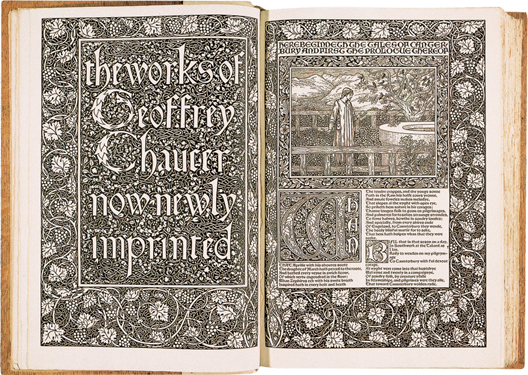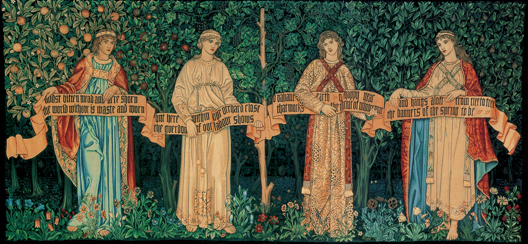In 1853 he went to Exeter College in Oxford at the same time as his friend Edward Burne-Jones, intending to enter the priesthood. Both belonged to a circle of aesthetes fascinated by an idealised vision of the Middle Ages, whose purpose was to “lead a crusade and a holy war against the contemporary era.” The members of this small group called themselves a brotherhood and read books together on theology, ecclesiastical history, and medieval poetry, as well as Tennyson’s poems and the writings of Ruskin. In 1855, still accompanied by Burne-Jones, he took a tour of the great Gothic cathedrals of northern France, and the two friends abandoned the priesthood to fully devote themselves to art. In early 1856 Morris began an apprenticeship with the architect George Edmund Street, during which he met his future collaborator Philip Webb. At the same time, he founded The Oxford and Cambridge Magazine and met Rossetti, who incited him to immediately abandon architecture for painting.
In 1857 he participated in the decoration of the Oxford Union Library’s walls. This was also the year that Morris met the woman who would be his wife and muse, Jane Burden. She was also one of Rossetti’s preferred models. In 1858 he published his story The Defence of Guenevere, which is now considered to be one of the most beautiful Victorian poems. The next year he married Jane Burden, and in 1859 they moved into the Red House designed for them by Philip Webb. After fitting out the house, Morris decided in 1861 to establish a decorating business with Rossetti, Webb, Burne-Jones, Madox Brown, Faulkner and Marshall. Morris and Burne-Jones were the firm’s principal designers but the entire Pre-Raphaelite community worked there, along with Arthur Hughes and William de Morgan.
In parallel with his decorating work, Morris began studying the Icelandic language in 1868, and with Eiríkr Magnússon he published his first translations of Icelandic sagas, The Saga of Gunnlaug Worm-Tongue and The Story of Grettir the Strong. Between 1868 and 1870 he published the four parts of The Earthly Paradise. After these accomplishments in decoration and literature, Morris became interested in politics. For him, the Socialist movement seemed to be the only solution to the problems of Victorian society, particularly the complications emerging from the industrial revolution.
In 1871 Morris and Rossetti became co-proprietors of Kelmscott Manor in Oxfordshire. Rossetti was very close to “Topsy”, his nickname for William, and Jane Morris, with whom he had an affair. In 1874 Morris took sole possession of Kelmscott without Rossetti, and for purely commercial reasons became the sole owner of the firm, known thereafter as Morris & Co.
Though he was becoming more and more involved in politics, he found time in 1875 to publish Sigurd the Volsung and Fall of the Nibelungs. In 1877 he founded the Society for the Protection of Ancient Buildings and gave his first public lecture on the decorative arts. In 1884 Morris wrote numerous essays on socialism that were read throughout England and Scotland. In the same year, he left the Social Democratic Federation and founded the Socialist League. In 1891 he founded the Kelmscott Press in Hammersmith, which published the Kelmscott Chaucer in 1896. This book was typeset by Morris and illustrated by Burne-Jones, and is an outstanding example of Morris’ ideas. He was skilled at combining beauty and utility in everyday objects, and though he was a poor painter, he helped to promote the Pre-Raphaelite ideal of beauty through his work. Like the Pre-Raphaelites, he fought for a more beautiful world, a return to the aesthetics of the Middle Ages, and a more demanding attitude towards the art objects that surround us. He died in 1896 and was buried in the cemetery of Kelmscott village.

William Morris,
The Works of Geoffrey Chaucer, 1896.
Book published by Kelmscott Press.
Paper, 42.5 x 29.2 cm (page).
Art Gallery and Museum, Cheltenham.

William Morris and John Henry Dearle (design)
and Morris, Marshall, Faulkner & Co. (production),
The Orchard, or The Seasons, c. 1863.
Tapestry woven in wool, silk and mohair on a
cotton warp, 221 x 472 cm.
Victoria & Albert Museum, London.
Index
A
Anonymous
Portrait of Burne-Jones and Morris.
Portrait of William Morris.
B
Brett, John
Glacier of Rosenlaui.
Vale of Aosta.
Brown, Ford Madox
Chaucer at the Court of Edward III.
Cordelia’s Potion.
An English Autumn Afternoon, Hampstead: Landscape.
The Hayfield.
Jesus Washing Peter’s Feet.
The Last of England.
Pretty Baa-Lambs.
“Take your son, sir”.
Walton-on-the-Naze.
Work.
Burne-Jones, Edward
The Baleful Head.
The Beguiling of Merlin.
The Briar Rose Series - Study for ‘The Garden Court,’.
The Challenge in the Desert.
Clara von Bork 1560.
The Golden Stairs.
King Cophetua and the Beggar Maid.
Laus Veneris.
The Merciful Knight.
The Perseus Series: Perseus and the Sea Nymphs (The Armament of Perseus).
The Perseus Series: The Rock of Doom.
Psyche’s Wedding.
Wedding Banquet of Sire Devrevaunt.
The Wheel of Fortune.
Burne-Jones, Edward (design) and Morris, Marshall, Faulkner & Co. (production)
Elaine.
Burne-Jones, Edward, William Morris and John Henry Dearle (design) and Morris & Co. (production)
Holy Grail Tapestry - Quest for the Holy Grail Tapestries - The Arming and Departure of the Knights.
C
Collins, Charles Allston
Convent Thoughts.
Collinson, James
The Renunciation of St. Elizabeth of Hungary.
Crane, Walter
La Belle Dame Sans Merci.
The Lady of Shalott.
D
Deverell, Walter Howell
Twelfth Night, Act II, Scene III.
Dicksee, Franck
Chivalry.
F
Fortescue-Brickdale, Eleanor
The Wise Virgins.
H
Hughes, Arthur
The Annunciation.
April Love.
The Brave Geraint.
The Eve of St. Agnes.
Home from Sea.
The Knight of the Sun.
The Long Engagement.
Ophelia.
Ophelia.
Self-Portrait.
Hughes, Edward Robert
Midsummer Eve.
Hunt, William Holman
The Awakening Conscience.
Claudio and Isabella.
A Converted British Family Sheltering a Christian Missionary from the Persecution of the Druids.
Dante Gabriel Rossetti.
The Eve of St. Agnes.
The Finding of the Savior in the Temple.
The Hireling Shepherd.
Isabella and the Pot of Basi.
John Everett Millais.
The Lady of Shalott.
The Light of the World.
London Bridge on the Night of the Marriage of the Prince and Princess of Wales.